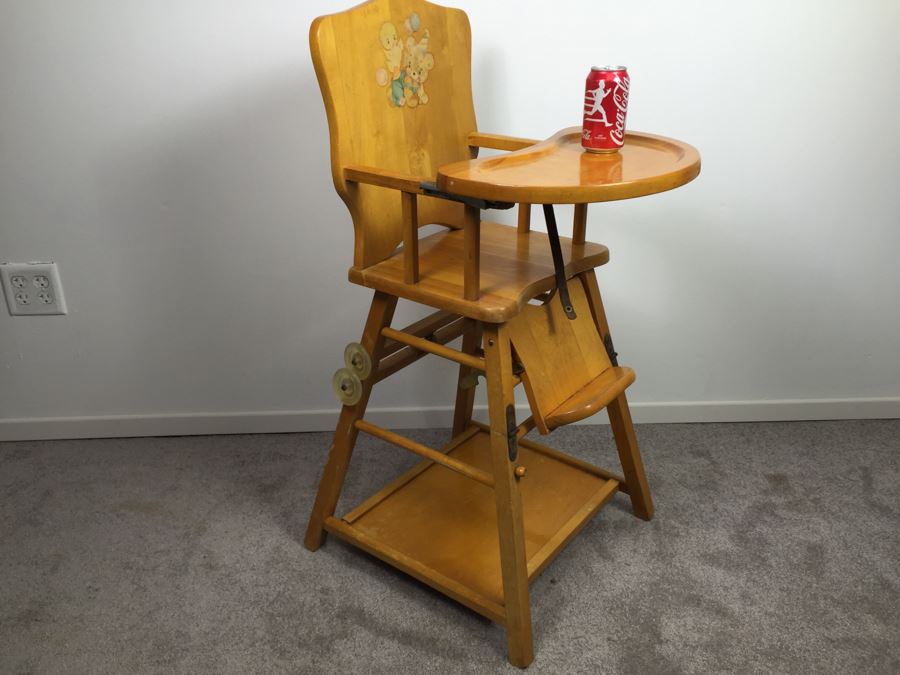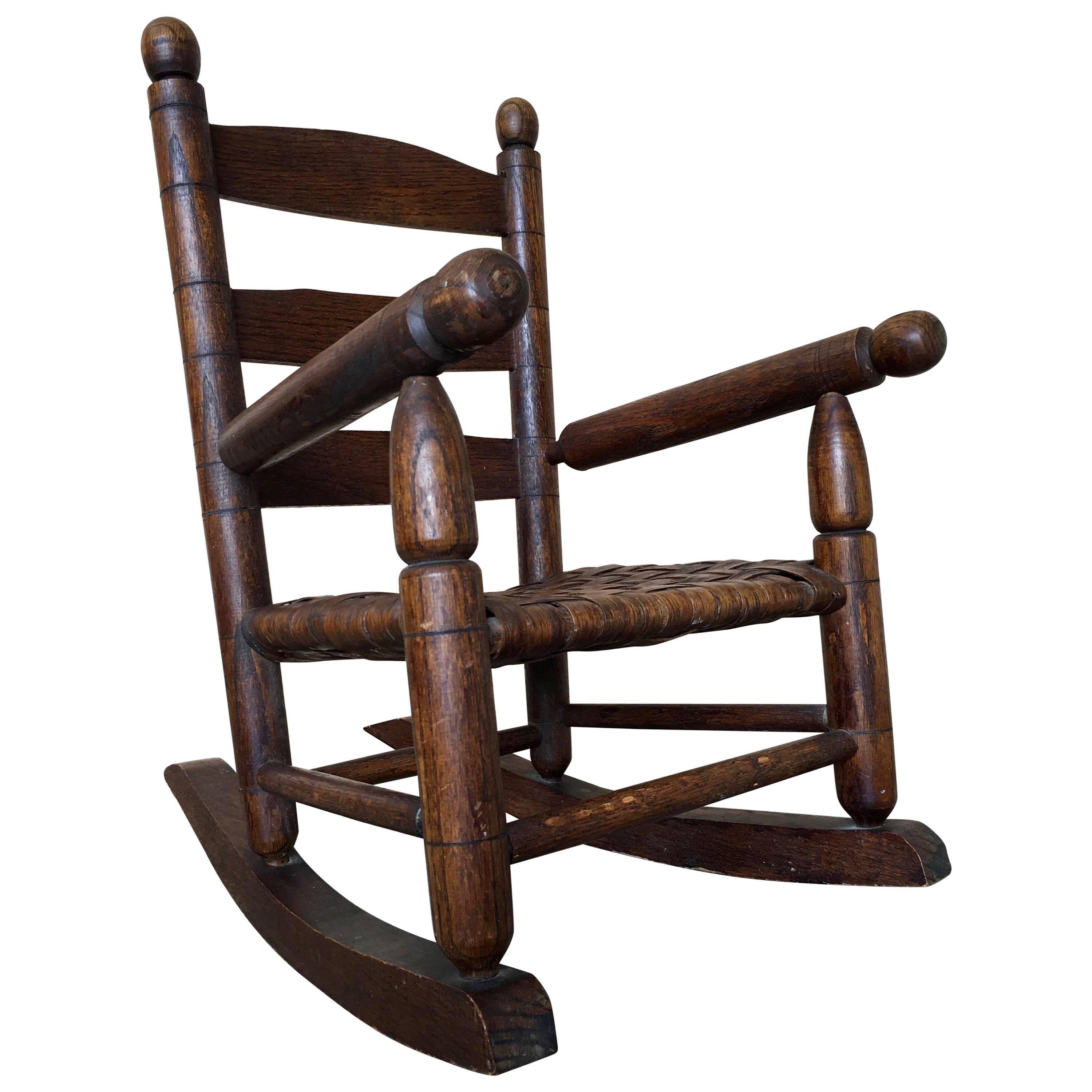Historical Significance and Evolution: Antique Wooden Baby Chair

Antique wooden baby chairs are more than just charming pieces of furniture; they represent a fascinating journey through history and evolving child-rearing practices. From the simple designs of the past to the intricate craftsmanship of the Victorian era, these chairs offer a glimpse into the lives of families across generations.
Evolution of Styles and Craftsmanship
Antique wooden baby chairs have evolved significantly over time, reflecting changing aesthetics and social norms.
- Early Designs (17th-18th Centuries): Early baby chairs were often quite basic, made from simple materials like wood and wicker. They were typically designed for functionality, with a high back and a wide, sturdy base for stability. These chairs often featured simple carvings or painted decorations. For example, the “high chair” with a tray for feeding was a common design in this period.
- Victorian Era (19th Century): The Victorian era witnessed a surge in elaborate designs and craftsmanship. Baby chairs became more ornate, featuring intricate carvings, decorative paintwork, and luxurious upholstery. Popular styles included the “high chair” with a padded seat and back, and the “go-cart” chair with wheels for easy mobility. These chairs often reflected the prevailing trends in Victorian design, with intricate details and a focus on elegance.
- Early 20th Century: The early 20th century saw a shift towards simpler designs, influenced by the Arts and Crafts movement. Baby chairs became more functional and less ornate, often featuring clean lines and natural materials. These chairs were designed to be practical and safe, with a focus on comfort and durability.
Social and Cultural Significance
Antique wooden baby chairs played a crucial role in child-rearing practices and family traditions.
- Symbol of Childhood: These chairs were often cherished family heirlooms, passed down through generations. They represented the innocence and vulnerability of childhood, serving as a reminder of the preciousness of young life.
- Social Status: The style and craftsmanship of a baby chair often reflected the social status of the family. Elaborately carved chairs with luxurious upholstery indicated wealth and privilege, while simpler designs were more common in working-class families.
- Family Traditions: Baby chairs were often used for special occasions, such as christenings and birthdays. They became part of family traditions, symbolizing the growth and development of a child.
Materials and Construction

Antique wooden baby chairs, often passed down through generations, embody a blend of practicality and artistry. Their construction, reflecting the craftsmanship of the past, showcases a unique combination of materials, techniques, and decorative elements.
Materials Used
The materials used in antique wooden baby chairs reflect the time period and geographic location of their creation. Here are some common materials:
- Wood Types: The most common wood types used in antique wooden baby chairs include oak, maple, cherry, walnut, and pine. These woods were selected for their durability, strength, and aesthetic appeal.
- Finishes: Antique baby chairs often feature a variety of finishes, including paints, varnishes, and stains. These finishes not only protect the wood but also enhance its natural beauty.
- Hardware: Hardware components, such as hinges, latches, and screws, were often made of iron or brass. These materials were chosen for their durability and resistance to rust.
Construction Techniques
Antique wooden baby chairs were meticulously crafted using traditional joinery techniques.
- Joinery Methods: Common joinery methods include mortise and tenon joints, dovetail joints, and lap joints. These techniques, which require precision and skill, ensure the chair’s stability and longevity.
- Carving Details: Carving was often incorporated into antique baby chairs, adding decorative touches and showcasing the craftsman’s artistry. Carvings could range from simple floral motifs to intricate scenes.
- Decorative Elements: Antique baby chairs often featured decorative elements, such as turned spindles, hand-painted details, and inlays. These embellishments not only enhanced the chair’s aesthetic appeal but also reflected the craftsmanship of the time.
Unique Design Features, Antique wooden baby chair
Antique wooden baby chairs often exhibit unique and innovative design features.
- Adjustable Height: Some antique baby chairs featured adjustable heights, allowing them to accommodate a growing child. This feature was often achieved through the use of sliding rails or adjustable legs.
- Folding Design: Folding designs were also incorporated into some antique baby chairs, making them more compact and easier to store. This feature was particularly useful in smaller homes.
- Built-in Toys: Some antique baby chairs incorporated built-in toys, such as rocking mechanisms or small compartments for toys. These features added a playful element to the chair, making it more engaging for children.
Identifying and Appreciating Antique Wooden Baby Chairs

So, you think you’ve got a vintage baby chair? It’s totally rad to be into antique stuff, but you gotta know how to spot the real deal from a modern knock-off. It’s all about the details, man!
Key Features and Characteristics of Antique Wooden Baby Chairs
Antique baby chairs are like time capsules, showing off the styles and techniques of their era. To tell if you’ve got a genuine antique, you gotta know what to look for. Here are some key features:
- Construction: Antique chairs were usually hand-crafted, with joints like dovetails, mortise and tenon, or pegged construction. Modern chairs are often mass-produced, using glue and screws. If you see glue or screws, it’s probably not an antique.
- Wood: Antique chairs were made from solid wood like oak, cherry, or maple. Modern replicas might use cheaper woods like pine or plywood. Look for signs of wear and patina on the wood, which show that it’s aged.
- Hardware: Antique chairs often have hand-forged hardware like hinges and latches. Modern replicas might have stamped or machine-made hardware.
- Finish: Antique chairs might have a natural finish or a shellac or varnish finish. Modern chairs often have polyurethane finishes. Look for signs of age and wear on the finish.
- Design: Antique chairs have unique designs that reflect the styles of their era. For example, Victorian chairs often have ornate carvings and high backs. Modern replicas might have more simplified designs.
Common Antique Baby Chair Styles
There are a bunch of different styles of antique baby chairs, each with its own vibe. Here’s a table that breaks down some of the most popular styles:
| Style | Distinctive Features | Historical Period |
|---|---|---|
| Victorian | Ornate carvings, high backs, often with a padded seat | 1837-1901 |
| Arts & Crafts | Simple, functional design, often with natural wood finishes | 1880-1920 |
| Mid-Century Modern | Clean lines, minimalist design, often with metal accents | 1940-1960 |
| Rocker | Features a rocking base, often with a high back and a padded seat | Various periods |
Evaluating Authenticity, Condition, and Value
So, you’ve found a sweet vintage baby chair. Now you gotta make sure it’s legit and worth your dough. Here’s a checklist to help you out:
- Authenticity: Check for signs of age, craftsmanship, and historical style as discussed above. Look for any identifying marks, labels, or stamps that might indicate the maker or origin.
- Condition: Assess the chair’s overall condition. Look for any cracks, splits, or other damage. Consider the finish and how well it’s been preserved. A chair in good condition is more valuable.
- Value: Research similar chairs online or with a local antique dealer to get an idea of its value. Factors like age, style, condition, and rarity can all affect the price.
The antique wooden baby chair, with its worn paint and gentle curves, whispers of childhood dreams long past. It sits in the corner, a silent sentinel of time, reminding us of the fleeting nature of youth. Just as the wooden swivel bankers chair offers a comfortable perch for contemplation, the baby chair evokes memories of a time when life was simple, filled with the innocence of childhood.
Now, the chair stands alone, a poignant reminder of the passage of time, and the bittersweet beauty of childhood’s fading memories.
The antique wooden baby chair, worn smooth by years of tiny hands, now sits silent in the corner. Its once vibrant paint faded, it holds the ghost of laughter and the echoes of tiny feet. Perhaps a wood frame hammock chair would offer a similar sense of gentle sway and comforting stillness, a place for quiet reflection and the memories of a time gone by.
The baby chair, though, remains a silent sentinel, a reminder of the fleeting nature of childhood and the enduring power of simple, handcrafted things.
